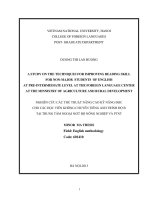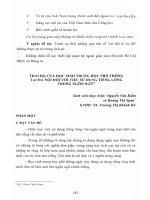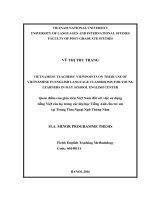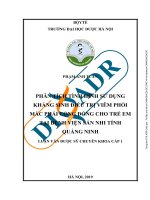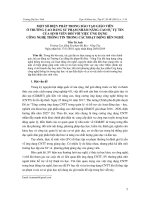Quan điểm của giáo viên Việt Nam đối với việc sử dụng tiếng Việt của họ trong các lớp học Tiếng Anh cho trẻ em tại Trung Tâm Ngoại Ngữ Tháng Năm
Bạn đang xem bản rút gọn của tài liệu. Xem và tải ngay bản đầy đủ của tài liệu tại đây (194.12 KB, 12 trang )
VIETNAM NATIONAL UNIVERSITY
UNIVERSITY OF LANGUAGES AND INTERNATIONAL STUDIES
FACULTY OF POST-GRADUATE STUDIES
VŨ THỊ THU TRANG
VIETNAMESE TEACHERS’ VIEWPOINTS ON THEIR USE OF
VIETNAMESE IN ENGLISH LANGUAGE CLASSROOMS FOR YOUNG
LEARNERS IN MAY SCHOOL ENGLISH CENTER
Quan điểm của giáo viên Việt Nam đối với việc sử dụng
tiếng Việt của họ trong các lớp học Tiếng Anh cho trẻ em
tại Trung Tâm Ngoại Ngữ Tháng Năm
M.A. MINOR PROGRAMME THESIS
Field: English Teaching Methodology
Code: 60140111
HANOI, 2016
VIETNAM NATIONAL UNIVERSITY
UNIVERSITY OF LANGUAGES AND INTERNATIONAL STUDIES
FACULTY OF POST-GRADUATE STUDIES
VŨ THỊ THU TRANG
VIETNAMESE TEACHERS’ VIEWPOINTS ON THEIR USE OF
VIETNAMESE IN ENGLISH LANGUAGE CLASSROOMS FOR YOUNG
LEARNERS IN MAY SCHOOL ENGLISH CENTER
Quan điểm của giáo viên Việt Nam đối với việc sử dụng
tiếng Việt của họ trong các lớp học Tiếng Anh cho trẻ em
tại Trung Tâm Ngoại Ngữ Tháng Năm
M.A. MINOR PROGRAMME THESIS
Field: English Teaching Methodology
Code: 60140111
Supervisor: Assoc. Prof. Nguyễn Xuân Thơm
HANOI, 2016
DECLARATION
I declare that this thesis submitted for the Master of Art degree at the
University of Languages and International Studies is a presentation of my own
research and has not been previously submitted at any other universities for any
degrees. Wherever contributions of other researchers are involved, every effort is
made to indicate this clearly, with due reference to the literature, and
acknowledgement o collaborative research and discussion. The work was done
under the guidance of Associated Professor Nguyen Xuan Thom, at the University
of Languages and International Studies.
Hanoi, 2016
Vũ Thị Thu Trang
1
ACKNOWLEDGEMENT
At the completion of this thesis, I would like to express my sincere thanks to
my lecturer and my supervisor, Mr. Nguyen Xuan Thom for his valuable support
and instructions without which it would have been really difficult for me to handle
the task.
I would like to acknowledge my debt to my colleagues in May School
English Center for their effective cooperation in collecting data for completing this
study. Their enthusiastic participation was indispensable to my research.
Finally, I would like to express my gratitude to my family for all the support
I received to finish this thesis.
2
ABSTRACT
The use of the mother tongue has been argued for ages in English language
teaching and the argument over whether students’ native language should be
included or excluded in English language classrooms has been a controversial issue.
Conducted in the context of Vietnam, the study is an attempt to address the use of
Vietnamese as mother tongue in English language classrooms in a prestigious
English center for young learners in Hanoi (May School). It focuses on the
viewpoints of Vietnamese teachers in May School on their use of Vietnamese as
mother tongue in their English language classrooms as well as the amount and
situations in which it is employed. The findings and discussion are based on the
analysis of the data collected from group interview of five female teachers and ten
one-hour classroom observations. The current study supports the judicious use of
Vietnamese in some situations such as giving instructions, responding to students’
Vietnamese. The results also highlight that the use of Vietnamese is significantly
different in classrooms in May School but the average amount of its use is quite
limited.
3
LIST OF ABRREVIATIONS
ALM:
Audio-Lingual Method
CLT:
Communicative Language Teaching
EFL:
English as a Foreign Language
ELT:
English Language Teaching
FL:
Foreign language
GMT:
Grammar Translation Method
L1:
First Language
L2:
Second Language
TL:
Target Language
4
LIST OF CHARTS AND TABLES
Chart 1: The amount of Vietnamese used in observed classes
Table 1: Participating teachers’ profile
Table 2: Information of observed classes
Table 3: The occasions of teachers’ use of Vietnamese in Starters classes
Table 4: The occasions of teachers’ use of Vietnamese in Movers classes
Table 5: The occasions of teachers’ use of Vietnamese in Flyers classes
5
REFERENCES
Al-Nofaie, H. (2010). The attitudes of teachers and students towards using Arabic in
EFL classrooms in Saudi public schools – A case study. Novitas Royal
Research in Youth and Language, 4(1), 64-95
Kieu Hang Kim Anh (2010). Use of Vietnamese in English language teaching
in
Vietnam: Attitudes of Vietnamese
Language
Teaching,
3(2),
university
119-128.
teachers.
English
Retrieved
from
www.ccsenet.org/journal/index.php/elt/article/download/5015/4912
Aqel, F. (2006). Using the mother tongue (Arabic language) in EFL. Journal of
Educational Sciences, 9
Atkinson, D. (1987). The mother tongue in the classroom: A neglected source?
ELT Journal, 41(4), 241-247
Auerbach, E. (1993). Reexamining English only in the ESL classroom.
TESOLQuarterly, 27(1), 9-32.
Cianflone, E. (2009). L1 use in English courses at university level. ESP World, 8
(22), 1-6
Cohen, L., Manion, L., & Morrison, K. (2007). Research methods in education. (6th
ed.). New York: Routledge.
Cook, V. (2001). Using the first language in the classroom. The Canadian Modern
Language Review/La Revue Canadienne des Langues Vivantes, 57(3), 402423.
Duff, P. A., Polio, C. G. (1990). How much foreign language is there in the foreign
language classroom? The modern language journal, 74(2), 154-166.
Edstrom, A. (2006). L1 use in the L2 classroom: One teacher’s self-evaluation.
Canadian Modern Language Review, 63(2), 275-292.
6
Hawks, P. (2001). Making Distinctions: A Discussion of the Mother Tongue in the
Foreign Language Classroom. Hwa Kang Journal of TEFL, 7, 47-55.
Phung Thi Hien (2012). Teachers’ use of the mother tongue in English language
classrooms for young learners at a language center: A case study.
Unpublished M.A thesis, Vietnam National University Hanoi, University of
Languages and International Studies, Hanoi.
Kang, D. (2008). The classroom Language use of a Korean Elementary School:
EFL teacher: another look at TETE. 36, 214- 226.
Kim, S. H. & Elder, C. (2005). Language choices and pedagogic functions in the
foreign language classroom: A cross-linguistic functional analysis of
teacher talk. Language Teaching Research 9(4), 355–380
Kim, Y. & Petraki, E. (2009). Students' and Teachers’ use of and Attitudes to L1 in
the EFL Classroom. The Asian EFL Journal, 11(4), 58-89.
Krashen, S. D. (1985). The Input Hypothesis: Issues and Implications. New York:
Longman.
Larsen-Freeman, D. (2000). Techniques and Principles in Language Teaching.
Oxford: Oxford University Press.
Levine, G. S. (2003). Student and instructor beliefs and attitudes about target
language use, first language use, and anxiety: Report of a questionnaire
study. Modern Language Journal, 87, 343-364.
Littlewood, W. & Yu, B. (2009). First language and target language in the foreign
language classroom. Language Teaching 44(1), 64-67
Liu, D., Ahn, G. S., Baek, K. S. & Han, N. O. (2004). South Korean high school
English teachers’ code switching: Questions and challenges in the drive for
maximal use of English in teaching. TESOL Quarterly 38(4), 605–638.
7
Macaro, E. (2001). Analyzing student teachers’ code switching in foreign language
classrooms. Modern Language Journal, 85, 531-548
Nguyen Thi Nhu Quynh. (2011). Teachers’ and students’ attitudes toward L1 using
in EFL classrooms at Ba Vi high school, Hanoi. Unpublished M.A thesis,
Vietnam National University Hanoi, University of Languages and
International Studies, Hanoi.
Pachler, N & Field, K. (2001). Learning to Teach Modern Foreign Languages in
the Secondary School. Routledge: London.
Phillipson, R. (1992). Linguistic Imperialism. Oxford University Press: Oxford.
Polio, C. (1994). Comments on Elsa Roberts Auerbach’s “Reexamining English
Only in the ESL Classroom”. TESOL Quarterly, 28(1), 153-161
Rabbidge, M. & Chappell, P. (2014). Exploring non-native English speaker teachers’
classroom language use in South Korea in elementary schools. The
Electronic Journal for English as a Second Language, 17(4). Retrieved
from www.tesl-ej.org/wordpress/issues/volume17/ej68/ej68a2/
Richards, J. & Rodgers, T. (1986). Approaches and Methods in Language Teaching.
Cambridge: Cambridge University Press.
Salah, N. M. H. & Farrah, M. A. H. (2012). Examining the Use of Arabic in English
Classes at the Primary Stage in Hebron Government Schools, Palestine:
Teachers’ Perspective. Arab World English Journal, 3(2), 400-436
Sharma, K. (2006). Mother tongue use in English classroom. Journal of NELTA, 11
(1-2), 80-87
Schweers, C. W. (1999). Using L1 in L2 classroom. English Teaching Forum, 37(2),
6-9
Tang, J. (2002). Using L1 in the English Classroom. English Teaching Forum,
40(1),
36-43.
Retrieved
/>8
from
Tran Ngoc Thuong (2010). An investigation into teachers’ and students’ attitudes
toward the use of mother tongue in English language classrooms at Hon
Gai high school. Unpublished M.A thesis, Vietnam National University
Hanoi, University of Languages and International Studies
Timor, T. (2012). Use of mother tongue in teaching a foreign language. Language
Education
in
Asia,
3(1).
7-17.
Retrieved
from
www.academia.edu/5599165/LEi_A_V3_I1_02_Timor_Use_of_the_Mothe
r_Tongue
Turnbull, M. (2001). There is a role for the L1in second and foreign language
teaching, but?. The Canadian Modern Language Review, 57(4), 531-5
Turnbull, M. & K. Arnett (2002). Teachers’ uses of the target and first languages in
second and foreign language classrooms. Annual Review of Applied
Linguistics 22, 204–218
Weschler, R. (1997). Uses of Japanese (L1) in the English Classroom: Introducing
the Functional- Translation Method. The Internet TESL Journal, 3(11).
9
I
